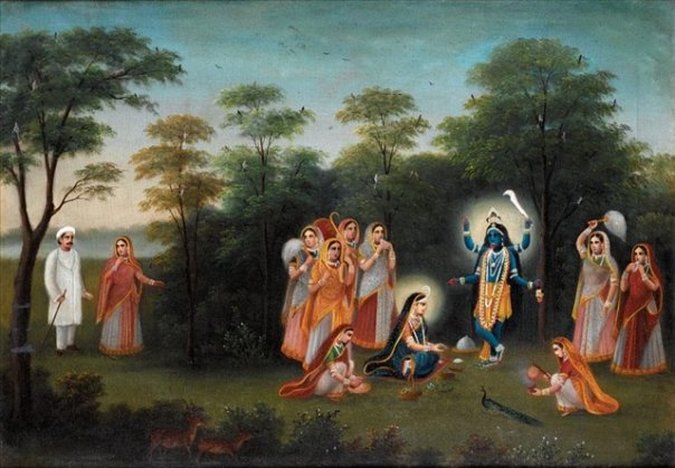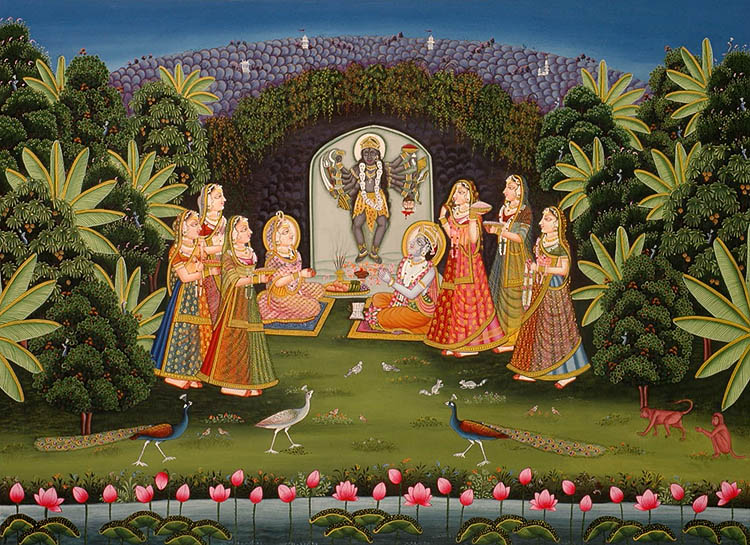Hindu tales narrate a nice story of how Krishna assumed the form of Kalee( Kali ) as a lila or divine play . The plot unflods in the puranic forest of Vrindavana where the cowherd Yadavas were peacefully residing with their much loved leader and friend , Sri Krishna.
Every night , hearing the flute of Krishna at midnight Srimati Radharani would quitely slip out from her home to secretly meet with her lover in the deep forests . However this was eventually observed by the shrewd sister in laws of Radha , Jatila and Kutila who informed her husband Ayan of his wife’s ‘adultery’.
Infuriated Ayan set off to punish the miscreant , into the deep woods . However the lord of all beings , Sri Krishna already knew what was in the air . He quickly asked Radha to pick up all the wild fruits and flowers that she could find and sit down at his feet in an worshupful gesture .
Radha obeyed to his commands and soon Krishna had himself transformed to Kali — the ishta or chosen deity of Ayan . and when Ayan finally arrived on the spot he found his wife doing puja of their family deity . Thus Srimati Radharani was saved .
In the last 500 years, shakti sadhaks of eastern India personally felt the unity of these two imoprtant forms of hindu pantheon . Many songs and poems were composed in honour of this united form which was named KRISHNA-KALI .
In many such song the sadhak poses himself as a little child requesting his loved mother to drop her ghastly look to assume the more pleasing form of Krishna with kadamba garlands , yellow robes and enchanting crown of flowers and peacock feathers .
This day is also commemorated in Bengal as Phalaharini Kalika Puja , which takes place in the amavasya(new moon might) of jyestha(april-may) month. this is a time when india is abound with scented flowers and sweetest of fruits like mango . so it is custom to offer all seasonal fruits to Kali at this day . offering of fruits also symbolises the surrender of ego and karmic reactions of a man to the supreme .
The video shows the transformation of Kali to Krishna set in the background of a song on the subject . It was written by a nineteenth century self realized kali sadhak known as Premik Maharaj . The first few lines of the song translates as.
” My mother has become Krishna on seeing the enchanting night of full moon in the season of spring .
My black moon(Kali) has now started the divine play of holi .
ah ! behold the mesmeric beauty on her body , which is now covered with coloured holi powders and blood .
Dakini , Sakini , Yogini , Hakini and all her other companions have become mad with divine love and thus have turned to gopinis (cowherd damsels).
Every night , hearing the flute of Krishna at midnight Srimati Radharani would quitely slip out from her home to secretly meet with her lover in the deep forests . However this was eventually observed by the shrewd sister in laws of Radha , Jatila and Kutila who informed her husband Ayan of his wife’s ‘adultery’.
Infuriated Ayan set off to punish the miscreant , into the deep woods . However the lord of all beings , Sri Krishna already knew what was in the air . He quickly asked Radha to pick up all the wild fruits and flowers that she could find and sit down at his feet in an worshupful gesture .
Radha obeyed to his commands and soon Krishna had himself transformed to Kali — the ishta or chosen deity of Ayan . and when Ayan finally arrived on the spot he found his wife doing puja of their family deity . Thus Srimati Radharani was saved .
In the last 500 years, shakti sadhaks of eastern India personally felt the unity of these two imoprtant forms of hindu pantheon . Many songs and poems were composed in honour of this united form which was named KRISHNA-KALI .
In many such song the sadhak poses himself as a little child requesting his loved mother to drop her ghastly look to assume the more pleasing form of Krishna with kadamba garlands , yellow robes and enchanting crown of flowers and peacock feathers .
This day is also commemorated in Bengal as Phalaharini Kalika Puja , which takes place in the amavasya(new moon might) of jyestha(april-may) month. this is a time when india is abound with scented flowers and sweetest of fruits like mango . so it is custom to offer all seasonal fruits to Kali at this day . offering of fruits also symbolises the surrender of ego and karmic reactions of a man to the supreme .
The video shows the transformation of Kali to Krishna set in the background of a song on the subject . It was written by a nineteenth century self realized kali sadhak known as Premik Maharaj . The first few lines of the song translates as.
” My mother has become Krishna on seeing the enchanting night of full moon in the season of spring .
My black moon(Kali) has now started the divine play of holi .
ah ! behold the mesmeric beauty on her body , which is now covered with coloured holi powders and blood .
Dakini , Sakini , Yogini , Hakini and all her other companions have become mad with divine love and thus have turned to gopinis (cowherd damsels).
Krishna Gave Darshan in the form of Kali
"(Amar Ujala) Navaratri is also being celebrated at the Kali Krishna temple in Gopinath Bazaar, Vrindavan. Although Vrindavan is generally associated with Krishna worship, there is a lot of Shakti worship going on here as well.
This is why the Kali Pith at this particular temple is considered an important place of worship in Vrindavan. One of the reasons given for this is that Krishna here appeared as Kali to Shrimati Radharani.
Krishna’s two arms became four, his flute became a scimitar, and the flower garland around his neck became a garland of skulls.
Head sevait of the Krishna Kali Pith, Keshavacharyaji, tells the story:
“Once Ayan Ghosh, Radha’s so-called husband, became doubtful that his wife was cheating on him. So one night, when Radha went to meet Krishna, he followed behind to try to catch them redhanded.
“But Krishna was aware of his plan and when Ayan came near, he took the form of Kali so that it appeared that Radha was engaged in secretly worshiping the Goddess in order to benefit her husband and his family. And so, instead of being angry with her, Ayan became respectful at seeing his devout and saintly wife engaged in religious activities on his behalf.”
The Kali Pith is said to be the place where this pastime transpired. Variations on this story can be found in other places, especially the last act of the Vidagdha-madhava.
"(Amar Ujala) Navaratri is also being celebrated at the Kali Krishna temple in Gopinath Bazaar, Vrindavan. Although Vrindavan is generally associated with Krishna worship, there is a lot of Shakti worship going on here as well.
This is why the Kali Pith at this particular temple is considered an important place of worship in Vrindavan. One of the reasons given for this is that Krishna here appeared as Kali to Shrimati Radharani.
Krishna’s two arms became four, his flute became a scimitar, and the flower garland around his neck became a garland of skulls.
Head sevait of the Krishna Kali Pith, Keshavacharyaji, tells the story:
“Once Ayan Ghosh, Radha’s so-called husband, became doubtful that his wife was cheating on him. So one night, when Radha went to meet Krishna, he followed behind to try to catch them redhanded.
“But Krishna was aware of his plan and when Ayan came near, he took the form of Kali so that it appeared that Radha was engaged in secretly worshiping the Goddess in order to benefit her husband and his family. And so, instead of being angry with her, Ayan became respectful at seeing his devout and saintly wife engaged in religious activities on his behalf.”
The Kali Pith is said to be the place where this pastime transpired. Variations on this story can be found in other places, especially the last act of the Vidagdha-madhava.
. . .
Kali and Krishna as Forms
As some people presume that Kali is the fierce aspect of Durga and Krishna is the god of love, there are adequate similarities between Kali and Krishna. These similarities are based on their forms and concepts. Here is a list of similarities between them.
The Dark Complexion : Both Kali and Krishna are either black or blue. The complexion represents the aura of the deity. The blue aura of Kali and Krishna represents divinity where as the black represents the darkness that consumes all evils.
Name : Both their names share a common meaning “the black one”. That is why Krishna is called Shyam and Kali is called Syama. Moreover in Bengal Krishna is called Jagannath and Kali is called Jaganmayee.
Nature and Cosmos : In Mahabharata Bala Krishna shows the whole cosmos inside his mouth to her mother Yashoda. In Hinduism it is believed that He is the holder of cosmos and Kali dances on cosmos so that every thing keeps going and the cycle of birth and death rotates. There is a deep connection between nature and cosmos to Krishna and Kali. Krishna is believed to be the holder of nature and cosmos and Kali is the cycle of birth and death of every being residing in it.
The Avatar philosophy : Krishna is the avatar of Vishnu and Kali is the avatar of Devi Mahatmayam. They descend for a common purpose to slay evil and restore truth and peace. Krishna is the slayer of Kamsa and Kali is the slayer of demons Chanda, Munda and Raktabija.
Association with battle field : Both of them are highly associated with battle fields. In Mahabharata Krishna is associated with the Battle of Kurukshetra and according to Devi Mahatmaya (Sri Sri Chandi) Kali is associated with the battle against Sumbha and Nisumbha.
Approachable forms : Krishna is the most approachable form of Vishnu and Kali is the most approachable form of the Mother Goddess. In India in most of the houses and workspaces (especially in hospitals) one will found the image of Kali or Krishna or both.
The Jagannath Idol : Jagannath of puri is considered the image of both Krishna and Dakshina Kali, Balabhadra as ‘Jyotirmayeem Tara’ and Devi Subhadra as ‘Adyasakti Bhubaneswari’. ‘Kalika Purana’ describes the four important Saktipitha and Orissa is one of them. The Dakshina Kali Temple of Puri has important religious associations with Jagannath Temple and it is believed that Daksinakali is the guardian of the kitchen of the Lord Jagannath Temple.
Deities with no mount : Krishna is seen with a Peacock and Kali with a Jackal. Other Hindu deities ride on their mount but Kali and Krishna never ride on them. Though Peacock and Jackal are symbolic but it also mean both of these deities work with the other beings of nature and each of every being has their own purpose.
Jay jay sri krishna-kaali








